陆地生活的动物双语
- 格式:ppt
- 大小:802.00 KB
- 文档页数:30

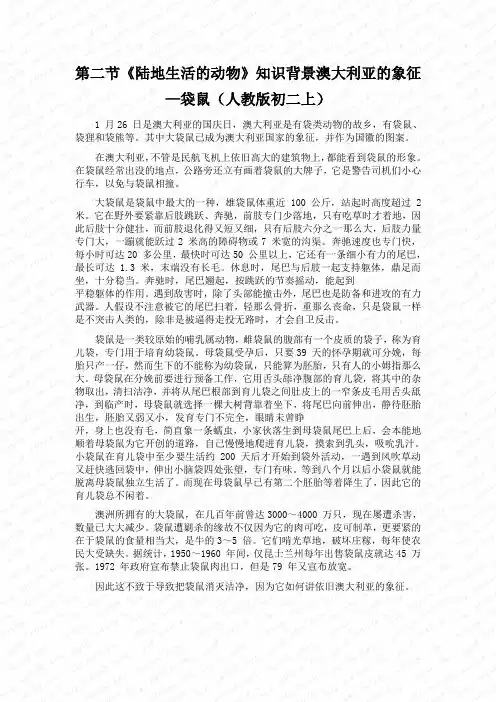
第二节《陆地生活的动物》知识背景澳大利亚的象征—袋鼠(人教版初二上)1 月26 日是澳大利亚的国庆日,澳大利亚是有袋类动物的故乡,有袋鼠、袋狸和袋熊等。
其中大袋鼠已成为澳大利亚国家的象征,并作为国徽的图案。
在澳大利亚,不管是民航飞机上依旧高大的建筑物上,都能看到袋鼠的形象。
在袋鼠经常出没的地点,公路旁还立有画着袋鼠的大牌子,它是警告司机们小心行车,以免与袋鼠相撞。
大袋鼠是袋鼠中最大的一种,雄袋鼠体重近100 公斤,站起时高度超过 2 米。
它在野外要紧靠后肢跳跃、奔驰,前肢专门少落地,只有吃草时才着地,因此后肢十分健壮,而前肢退化得又短又细,只有后肢六分之一那么大,后肢力量专门大,一蹦就能跃过2 米高的障碍物或7 米宽的沟渠。
奔驰速度也专门快,每小时可达20 多公里,最快时可达50 公里以上,它还有一条细小有力的尾巴,最长可达 1.3 米,末端没有长毛。
休息时,尾巴与后肢一起支持躯体,鼎足而坐,十分稳当。
奔驰时,尾巴翘起,按跳跃的节奏摇动,能起到平稳躯体的作用。
遇到敌害时,除了头部能撞击外,尾巴也是防备和进攻的有力武器。
人假设不注意被它的尾巴扫着,轻那么骨折,重那么丧命,只是袋鼠一样是不突击人类的,除非是被逼得走投无路时,才会自卫反击。
袋鼠是一类较原始的哺乳属动物,雌袋鼠的腹部有一个皮质的袋子,称为育儿袋,专门用于培育幼袋鼠。
母袋鼠受孕后,只要39 天的怀孕期就可分娩,每胎只产一仔,然而生下的不能称为幼袋鼠,只能算为胚胎,只有人的小姆指那么大。
母袋鼠在分娩前要进行预备工作,它用舌头舔净腹部的育儿袋,将其中的杂物取出,清扫洁净,并将从尾巴根部到育儿袋之间肚皮上的一窄条皮毛用舌头舐净,到临产时,母袋鼠就选择一棵大树背靠着坐下,将尾巴向前伸出,静待胚胎出生,胚胎又弱又小,发育专门不完全,眼睛未曾睁开,身上也没有毛,简直象一条蠕虫,小家伙落生到母袋鼠尾巴上后,会本能地顺着母袋鼠为它开创的道路,自己慢慢地爬进育儿袋,摸索到乳头,吸吮乳汁。



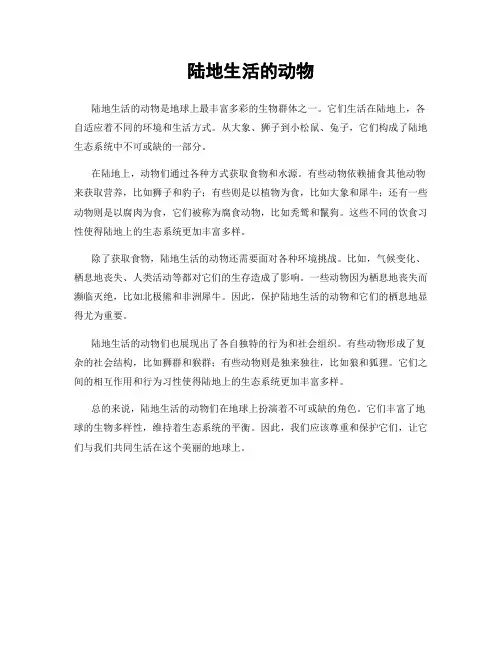
陆地生活的动物
陆地生活的动物是地球上最丰富多彩的生物群体之一。
它们生活在陆地上,各自适应着不同的环境和生活方式。
从大象、狮子到小松鼠、兔子,它们构成了陆地生态系统中不可或缺的一部分。
在陆地上,动物们通过各种方式获取食物和水源。
有些动物依赖捕食其他动物来获取营养,比如狮子和豹子;有些则是以植物为食,比如大象和犀牛;还有一些动物则是以腐肉为食,它们被称为腐食动物,比如秃鹫和鬣狗。
这些不同的饮食习性使得陆地上的生态系统更加丰富多样。
除了获取食物,陆地生活的动物还需要面对各种环境挑战。
比如,气候变化、栖息地丧失、人类活动等都对它们的生存造成了影响。
一些动物因为栖息地丧失而濒临灭绝,比如北极熊和非洲犀牛。
因此,保护陆地生活的动物和它们的栖息地显得尤为重要。
陆地生活的动物们也展现出了各自独特的行为和社会组织。
有些动物形成了复杂的社会结构,比如狮群和猴群;有些动物则是独来独往,比如狼和狐狸。
它们之间的相互作用和行为习性使得陆地上的生态系统更加丰富多样。
总的来说,陆地生活的动物们在地球上扮演着不可或缺的角色。
它们丰富了地球的生物多样性,维持着生态系统的平衡。
因此,我们应该尊重和保护它们,让它们与我们共同生活在这个美丽的地球上。
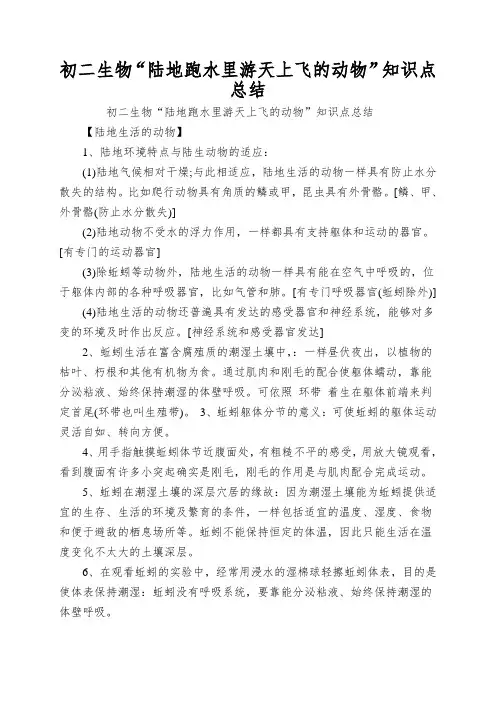
初二生物“陆地跑水里游天上飞的动物”知识点总结初二生物“陆地跑水里游天上飞的动物”知识点总结【陆地生活的动物】1、陆地环境特点与陆生动物的适应:(1)陆地气候相对干燥;与此相适应,陆地生活的动物一样具有防止水分散失的结构。
比如爬行动物具有角质的鳞或甲,昆虫具有外骨骼。
[鳞、甲、外骨骼(防止水分散失)](2)陆地动物不受水的浮力作用,一样都具有支持躯体和运动的器官。
[有专门的运动器官](3)除蚯蚓等动物外,陆地生活的动物一样具有能在空气中呼吸的,位于躯体内部的各种呼吸器官,比如气管和肺。
[有专门呼吸器官(蚯蚓除外)](4)陆地生活的动物还普遍具有发达的感受器官和神经系统,能够对多变的环境及时作出反应。
[神经系统和感受器官发达]2、蚯蚓生活在富含腐殖质的潮湿土壤中,:一样昼伏夜出,以植物的枯叶、朽根和其他有机物为食。
通过肌肉和刚毛的配合使躯体蠕动,靠能分泌粘液、始终保持潮湿的体壁呼吸。
可依照环带着生在躯体前端来判定首尾(环带也叫生殖带)。
3、蚯蚓躯体分节的意义:可使蚯蚓的躯体运动灵活自如、转向方便。
4、用手指触摸蚯蚓体节近腹面处,有粗糙不平的感受,用放大镜观看,看到腹面有许多小突起确实是刚毛,刚毛的作用是与肌肉配合完成运动。
5、蚯蚓在潮湿土壤的深层穴居的缘故:因为潮湿土壤能为蚯蚓提供适宜的生存、生活的环境及繁育的条件,一样包括适宜的温度、湿度、食物和便于避敌的栖息场所等。
蚯蚓不能保持恒定的体温,因此只能生活在温度变化不太大的土壤深层。
6、在观看蚯蚓的实验中,经常用浸水的湿棉球轻擦蚯蚓体表,目的是使体表保持潮湿:蚯蚓没有呼吸系统,要靠能分泌粘液、始终保持潮湿的体壁呼吸。
7、大雨过后蚯蚓会纷纷爬到地面上来缘故:大雨过后,过多的雨水会将土壤中的空气排挤出去,因此穴居的蚯蚓被迫爬到地表上来呼吸。
9、蚯蚓的呼吸过程:蚯蚓的体壁密布毛细血管,空气中的氧气先溶解在体表粘液里,然后进入体壁的毛细血管中。
体内的二氧化碳也经体壁的毛细血管由体表排出。
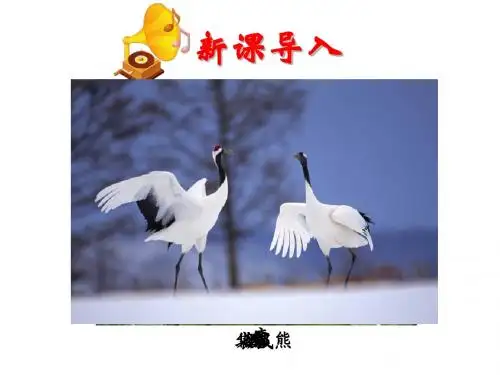
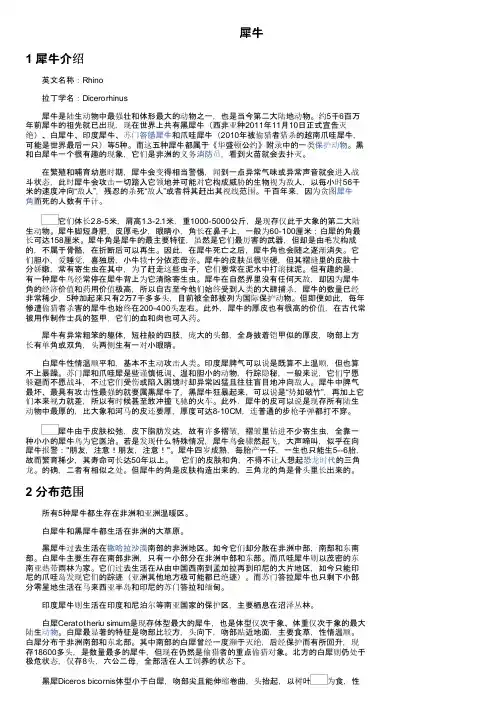
犀牛1 犀牛介绍 英文名称:Rhino 拉丁学名:Dicerorhinus 犀牛是陆生动物中最强壮和体形最大的动物之一,也是当今第二大陆地动物。
约5千6百万年前犀牛的祖先就已出现,现在世界上共有黑犀牛(西非亚种2011年11月10日正式宣告灭绝)、白犀牛、印度犀牛、苏门答腊犀牛和爪哇犀牛(2010年被偷猎者猎杀的越南爪哇犀牛,可能是世界最后一只)等5种。
而这五种犀牛都属于《华盛顿公约》附录中的一类保护动物。
黑和白犀牛一个很有趣的现象,它们是非洲的义务消防员,看到火苗就会去扑灭。
在繁殖和哺育幼崽时期,犀牛会变得相当警惕,闻到一点异常气味或异常声音就会进入战斗状态,此时犀牛会攻击一切踏入它领地并可能对它构成威胁的生物视为敌人,以每小时56千米的速度冲向“敌人”,残忍的杀死“敌人”或者将其赶出其视线范围。
千百年来,因为贪图犀牛角而死的人数有千计。
它们体长2.8-5米,肩高1.3-2.1米,重1000-5000公斤,是现存仅此于大象的第二大陆生动物。
犀牛脚短身肥,皮厚毛少,眼睛小,角长在鼻子上,一般为60-100厘米;白犀的角最长可达158厘米。
犀牛角是犀牛的最主要特征,虽然是它们最厉害的武器,但却是由毛发构成的,不属于骨骼,在折断后可以再生。
因此,在犀牛死亡之后,犀牛角也会随之逐渐消失。
它们胆小,爱睡觉,喜独居,小牛犊十分依恋母亲。
犀牛的皮肤虽很坚硬,但其褶缝里的皮肤十分娇嫩,常有寄生虫在其中,为了赶走这些虫子,它们要常在泥水中打滚抹泥。
但有趣的是,有一种犀牛鸟经常停在犀牛背上为它清除寄生虫。
犀牛在自然界里没有任何天敌,却因为犀牛角的经济价值和药用价值极高,所以自古至今他们始终受到人类的大肆捕杀,犀牛的数量已经非常稀少,5种加起来只有2万7千多多头,目前被全部被列为国际保护动物。
但即便如此,每年惨遭偷猎者杀害的犀牛也始终在200-400头左右。
此外,犀牛的厚皮也有很高的价值,在古代常被用作制作士兵的盔甲,它们的血和肉也可入药。
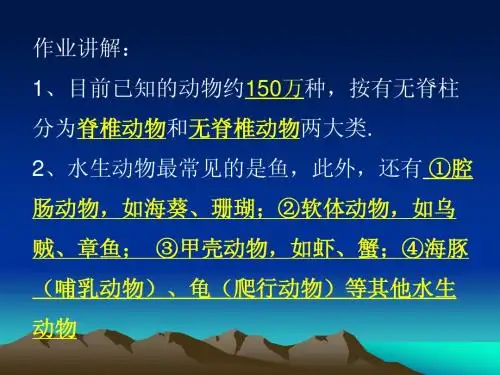
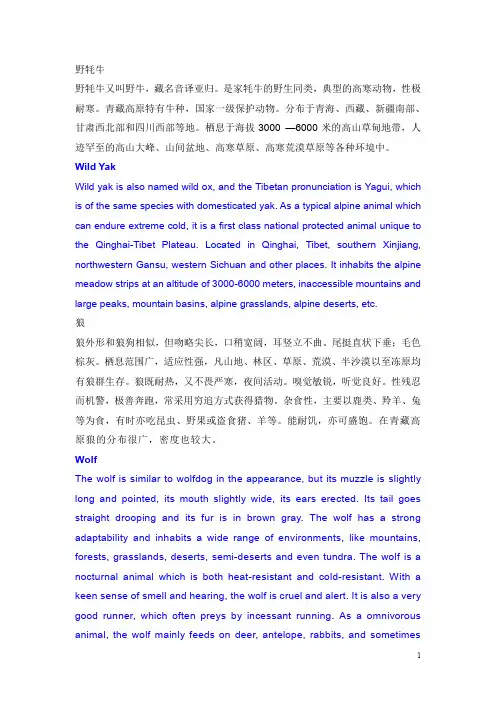
野牦牛野牦牛又叫野牛,藏名音译亚归。
是家牦牛的野生同类,典型的高寒动物,性极耐寒。
青藏高原特有牛种,国家一级保护动物。
分布于青海、西藏、新疆南部、甘肃西北部和四川西部等地。
栖息于海拔3000 —6000米的高山草甸地带,人迹罕至的高山大峰、山间盆地、高寒草原、高寒荒漠草原等各种环境中。
Wild YakWild yak is also named wild ox, and the Tibetan pronunciation is Yagui, which is of the same species with domesticated yak. As a typical alpine animal which can endure extreme cold, it is a first class national protected animal unique to the Qinghai-Tibet Plateau. Located in Qinghai, Tibet, southern Xinjiang, northwestern Gansu, western Sichuan and other places. It inhabits the alpine meadow strips at an altitude of 3000-6000 meters, inaccessible mountains and large peaks, mountain basins, alpine grasslands, alpine deserts, etc.狼狼外形和狼狗相似,但吻略尖长,口稍宽阔,耳竖立不曲。
尾挺直状下垂;毛色棕灰。
栖息范围广,适应性强,凡山地、林区、草原、荒漠、半沙漠以至冻原均有狼群生存。
狼既耐热,又不畏严寒,夜间活动。
嗅觉敏锐,听觉良好。
性残忍而机警,极善奔跑,常采用穷追方式获得猎物。
描写濒临危机动物的英语作文北极熊描写濒临危机动物的英语作文北极熊北极熊,是世界上最大的陆地食肉动物,又名白熊。
下面是小编分享的描写濒临危机动物的英语作文北极熊,欢迎大家阅读!写濒临危机动物的英语作文北极熊篇一:When the Arctic Ocean freezes over in the autumn, polar bears set off in search of their favorite meals: fatty ringed seals and bearded seals. By the summer, the sea ice begins to melt and break apart. Deprived of access to the tasty seals, polar bears spend the summer fasting. At least, that's what's supposed to happen. As the planet warms, the warmer ice-free season is getting longer and longer. So what's a hungry bear to do?Scientists once thought that polar bears might survive by supplementing their pinniped diet by turning to terrestrial foods like snow geese, their eggs and caribou."We've had this debate in the literature about whether terrestrial foods are nutritionally relevant to polar bears during the on-land season when the ice has melted."University of Alberta biologist Nick Pilfold."And we've known for a long time, going back to research in the early 70s, even going to back to early explorer logs, that polar bears will consume terrestrial based foods. But the debate was always whether those foods actually add up, energetically." In other words, do these substitutes provide enough nutrition to make up for the lost seals?To find out, Pilfold and his colleagues estimated the weight lost each day by polar bears in the wilds of western Hudson Bay during the ice-free season, when they could ostensibly be chowing down on terrestrial foods. Then they compared that tothe weight lost by bears that are temporarily held in Manitoba's Polar Bear Alert Program.While captive, the bears do not eat. They drop about one kilogram each day. But the wild bears, who had access to the Arctic snack bar, lost the same amount of weight each day. The results are in the journal Physiological and Biochemical Zoology."Which is really saying that the terrestrial foods do not have dense enough energy to offset the mass loss. So this idea that bears can just switch from eating sea ice–based food to land food and that's going to help supplement against longer ice-free seasons, that really doesn't show up in the data."The problem is that polar bears evolved to rely on the marine diet."The food on land is protein and carbohydrate based, and the food the polar bears really focus on is fat. Fat is the name of the game for these bears; they're highly adapted to absorbing that fat into their system and putting it onto their body as body mass, so they can fast on it later on. And the only thing that's going to provide them with that type of fat are marine mammals. And they can only access those marine mammals when there's sea ice."Adult males can go eight months without food. But younger, sub-adult bears, which are no longer nursing and must hunt, can't last as long without sea ice. So as the Arctic warms, younger polar bears will disproportionately die out. Leaving the species' survival in doubt.北冰洋在秋季结冰以后,北极熊就会出发去寻求它们最喜欢的食物:富含脂肪的海豹和胡子海豹。
中英文动物及海洋生物名称大全Aadder, viper 蝰蛇albatross 信天翁alligator 短吻鳄, 美洲鳄alpaca 羊驼anchovy 凤尾鱼anglerfish 安康鱼anopheles 按蚊,疟蚊ant 蚂蚁anteater 食蚁兽antilope 羚羊armadillo 犰狳ass, donkey 驴Bbadger 獾bald eagle 白头鹰bat 蝙蝠bear 熊beaver 河狸bedbug, bug 臭虫bee, honeybees 蜜蜂beetle 甲虫, 金龟子billy 雄山羊bird of paradise 极乐鸟, 天堂鸟bison 美洲野牛bitch 雌狗blackbird 乌鸫boa 王蛇boar 雄猪, 种猪brood 鸡的统称buck 公兔buffalo 水牛bull, ox 雄牛bullfrog 牛蛙bullock, steer 小阉牛bumble bee 大黄蜂butterfly 蝴蝶ccabbage butterfly 纹白蝶caiman,cayman 凯门鳄calf 小牛,牛犊calf(pl。
calves)年幼的牛camel 骆驼canary 金丝雀carp 鲤鱼cat 猫caterpillar 毛虫catta 雌猫cattle 牛centipede 蜈蚣chaffinch 苍头燕chameleon 变色龙,避役chick 小鸡chicken 鸡,雏鸡chimpanzee 黑猩猩chinchilla 南美栗鼠chub 鲢鱼cicada 蝉clam 蚌cob 雄天鹅cobra 眼镜蛇cock 公鸡cock,rooster 公鸡cockatoo 大葵花鹦鹉cockle 鸟蛤cockroach 蟑螂cod 鳕鱼colt,foal 马驹,小马condor 秃鹰copperhead 美洲腹蛇coral snake 银环蛇cormorant 鸬鹚cow 雌牛,母牛crab 蟹crayfish 小龙虾,喇蛄cricket 蟋蟀crocodile 鳄鱼,非洲鳄crow 乌鸦crucian 鲫鱼cuckoo 杜鹃,布谷鸟cuttloefish 乌贼cygnet 小天鹅deer 鹿D-Hdog 狗dog 雄狗dolphin 河豚donkey, ass 驴dormouse 睡鼠dove 鸽dragonfly 蜻蜓dromedary 单峰驼drone 雄蜂duck 鸭duckbill, platypus 鸭嘴兽eagle 鹰eel 鳗鱼elephant 象ewe 母羊ferret 雪貂flea 跳flock 绵羊的统称fly 苍蝇foal, colt, filly 幼马fox 狐frog 青蛙gaggle 鹅的统称gander 雄鹅gander, wild goose 雁gannet 塘鹅gavial 印度鳄gazelle 小羚羊gelding 阉割的马giant salamander 娃娃鱼, 鲵gibbon 长臂猿gilt 小母猪giraffe 长颈鹿glowworm, firefly 萤火虫goat 山羊golden eagle 鹫goldfinch 金翅雀goose 雌鹅goose 鹅gopher 囊地鼠gorilla 大猩猩gosling 幼鹅grass snake 草蛇grasshopper 蚱蜢grouse 松鸡guanaco 原驼Guinea pig 豚鼠guinea, fowl 珍珠鸡gull, seagull 海鸥hake 无须鳕hare 野兔hawk, falcon 隼hedgehog 刺猬heifer 小母牛hen 母鸡herd 牛的统称herd 猪的统称hermit crab 寄居蟹heron 苍鹰herring 青鱼, 鲱hinny 驴骡hippopotamus 河马hog 阉猪, 肥猪horse 马horsefly, gadfly 厩蝇,牛虻hummingbird 蜂雀hyena, hyaena 鬣狗I-Qiguana 鬣蜥Japanese beetle 日本金龟子jenny ass 雌驴kangaroo 袋鼠kid 年幼的山羊kingfisher 翠鸟kite 鹞kitten 小猫kitten, kitty, pussy 小猫koala 考拉, 树袋熊ladybird 瓢虫lamb 羊羔,羔羊large prawn 大对虾lark 百鸟,云雀leopard 豹lion 狮lizard 蜥蜴llama 大羊驼lobster 龙虾locust 蝗虫louse, lice 虱子, 白虱lynx 猞猁macaw 金刚鹦鹉mackerel 鲭,鲐magpie 喜鹊male ant 雄蚁mallard 野鸭, 凫mare 母马marmot 土巴蜀moccasin 嗜鱼蛇mole 鼹鼠monkey 猴子mosquito 蚊moth 蛾mouse 家鼠mullet 乌鱼, 黑鱼mussel 淡菜,贻贝mustang 野马mutton 羊肉nanny 雌山羊nightingale 夜莺Norway lobster 蝉虾octopus 章鱼orangutan 猩猩ostrich 鸵鸟otter 水獭owl 枭,猫头鹰ox 牛oyster 牡蛎pale clouded yellow 纹黄蝶panther, puma 美洲豹parakeet 长尾鹦鹉parrot 鹦鹉partridge 石鸡, 鹧鸪peacock 孔雀pelican 鹈鹕penguin 企鹅perch 鲈鱼pheasant 雉, 野鸡pig,ne 猪pigeon 野鸽piglet, shoat 年幼的猪pike 梭子鱼plaice 鲽plover 千鸟pony 矮马porcupine 箭猪, 豪猪porpoise 大西洋鼠海豚poult 小火鸡prawn 虾praying mantis 螳螂ptarmigan 雷鸟pup 年幼的狗python 蟒蛇quail 鹌鹑queen ant 蚁后queen bee 蜂王R-Zrabbit 兔rabbit 兔子ram 雄绵羊rat 鼠rattlesnake 响尾蛇ray 鳐鱼red mullet, surmullet 羊鱼reindeer 驯鹿rhinoceros 犀牛robin 知更鸟sailfish 旗鱼salamander, triton, newt 蝾螈salmon 鲑鱼sardine 沙丁鱼scallop 扇贝scops owl 角枭,耳鸟scorpion 蝎子sea bream 海鲷sea horse 海马sea turtle 海龟sea urchin 海胆seal 海豹shark 鲨鱼sheep 绵羊shrimp 对虾silkworm moth 蚕蛾silverfish 蠹虫skipjack 鲣鱼sloth 獭猴snail 蜗牛snake 蛇snipe 鹬sole 舌鳎sow 雌猪sparrow 麻雀spider 蜘蛛spider crab 蜘蛛蟹spiny lobster, rock lobster 大螯虾squid 枪乌贼,鱿鱼squirrel 松鼠stallion 雄马starling 八哥stink bug 椿象stork 鹳sturgeon 鲟鱼sulphur butterfly 白蝴蝶sunfish 翻车鱼swallow 燕子swallowtail 凤尾蝶swan 天鹅swordfish 剑鱼tabby, she-cat, grimalkin 雌猫tarantula 多毛毒蜘蛛tarpon 大海鲢teal 小野鸭termite 蚁thoroughbred 纯种马thrush 画眉tiger 虎toad 蟾蜍tom 雄火鸡tomcat 雄猫tomcat 雄猫, 公猫tortoise 玳瑁trout 鳟鱼tuatara 古蜥蜴tunny, tuna 金枪鱼turbot 大菱鲆turkey 火turtle 龟turtle dove 斑鸠vicuna 小羊驼vole 田鼠vulture 秃鹫wall lizard 壁虎walrus 海象wasp 黄蜂, 胡蜂water buffalo 水牛weasel 鼬,黄鼠狼whale 鲸white ant 白蚁whitethroat 白喉雀whiting 小无须鳕wiggler 孑孓wildcat 野猫wolf 狼woodcock 山鹬woodpecker 啄木鸟worker ant 工蚁yak 牦牛yak 牦牛zebra 斑马海洋生物英文名称海星starfish 珊瑚coral 螃蟹crab章鱼octopus 龙虾lobster 贝类shell鲨鱼shark 海参sea slug 乌贼cuttlefish 虾子prawn 海豚dolphin 金鱼gold fish 白带鱼hair tail fish 牡蛎oyster珊瑚coral、海胆sea urchin、虾shrimp、水母jellyfish、海马sea horse、乌贼cuttlefish、章鱼octopus、海牛manatee、lionfish狮子鱼、魟鱼ray、鲸whale、海星starfish、海豚dolphin、鲨鱼shark、海龟sea turtle、寄居蟹hermit crab、海獭sea otter、海狗fur seal、海象walrus、海豹seal、海葵sea anemone、海绵sponge、蟹crab、管口鱼trumpetfish、小丑鱼clownfish、海狮sea lion、金鳞鱼squirrel fish、蝶鱼butterfly fish、比目鱼flounder、刺河魨porcupine fish、海蛇sea snake、阳燧足brittle star木瓜鱼trunk fish 石斑鱼grouper 鹦哥鱼parrotfish 海星sea star 六线笛鲷grunt 六间雀鲷sergeant major 神仙鱼angel fish 蝶鱼butterfly fish 中国鲎(马蹄蟹) horse foot king crab horse shoe 刺河豚balloon fish 乌贼squid 螺cone 珊瑚coral 海鸥gull 羊鱼goatfish 水母jellyfish 龙虾lobster 水蛭leech 狮子鱼lion fish 鳐鱼manta 蚝oyster 海豚dolphin 大象耳海棉elephone ear sponge 海鳗eel 海水salt water 淡水fresh water 巨浪surge surf 海扇sea fan 海参sea cucumber 海胆sea urchin 千手海葵sea anemone 海蛇sea snake 石狗公sting fish 岩石峭壁rocky cliffBQF:Block Quick Frozen 块状速冻;IQF:individual Quick Frozen 单体速冻;1.water fowl 水产;2.river crab 螃蟹;3.fish 鱼;4.an octopus 章鱼;5.calamary 鱿鱼;6.a toad 虾;7.mussel 蚌;8.a whorl 螺;这里为大家介绍日常能买到和食用的鱼,包括图片、中英名字、分类和简介,方便大家识别购买鱼肉。
陆地生活的动物第五单元生物圈中的其他生物第一章各种环境中的动物第二节陆地生活的动物教师寄语:适合自己的,才是最好的!重点难点:本节的重点是总结概括出陆地生活的动物在运动、呼吸和对刺激的反应等方面适应陆地环境的特点。
通过对蚯蚓的实验、观察、讨论、交流,描述蚯蚓形态结构和生理功能。
通过对兔的“观察与思考”,总结出陆地生活的动物类群适应陆地环境的主要特点,并概括哺乳动物的主要特征。
本节难点是引导学生通过比较、实验、观察与思考等学习活动来获取知识,培养总结和概括的能力,并进行情感价值观的教育。
学习目标:知识目标:1.通过比较能够阐明各类陆生动物适应陆地环境的形态结构特征和生理功能的特征。
2.通过实验和观察等活动,阐明蚯蚓和兔在运动、呼吸等方面与其陆地生活环境相适应的特点。
概述环节动物、哺乳动物的主要特征;能力目标:提高学生的观察能力,培养学生提高认识问题、分析问题的能力。
强化“生物与其生活环境相适应”的观点。
情感目标:提高学生爱护动物的意识. 关注动物栖息地的保护学习过程:一、课前预习:1、说出陆生动物与陆地干燥环境相适应的一系列的特点。
2、描述蚯蚓的生活环境和生活习性。
3、介绍家兔的形态特点和饲喂方法。
二、导入新课前面我们通过对水生动物的学习,知道了水生生物对环境的适应,那么,陆生动物的生活环境又是怎样的?它们又是怎样适应环境的呢?三、合作探究(一)陆地生活的动物对环境的适应请同学们观察分析教材第12-13页图片资料,讨论交流,概括出陆地生活的动物在运动、呼吸和对环境的反应等方面适应陆地环境的特点。
1、2、3、4、(二)蚯蚓请同学们仔细阅读教材14—15页“饲养和观察蚯蚓”实验,并结合自己的经验,小组内展开讨论,畅所欲言,分析回答下列问题:1、各小组描述采集蚯蚓的环境及生活习性。
2、取一条活蚯蚓放在玻璃板上观察它的外部形态(身体的分节情况、触摸感觉其腹面的刚毛及体表是否有黏液,有什么作用;如何区别身体的前后端等)。
生活在陆地上的动物的英语Land animals are a diverse group of creatures that live on Earth's surface. They range in size from the tiny shrew to the massive elephant, and are found in almost every habitat, including forests, deserts, grasslands, and mountains. Some common examples of land animals include:1. Mammals - This group includes animals that have fur, mammary glands, and give birth to live young. Some well-known mammal species are lions, tigers, bears, wolves, deer, horses, and cows.2. Birds - These animals are known for their ability to fly, but not all of them can. Examples of terrestrial birds are ostriches, emus, and penguins.3. Reptiles - This group of animals includes lizards, snakes, turtles, and crocodiles. They have scaly skin, lay eggs, and are cold-blooded.4. Amphibians - Amphibians go through a metamorphosis and have moist skin. Examples include frogs, toads, and salamanders.5. Insects - This group is the most diverse of all land animals, including beetles, butterflies, ants, bees, and spiders.6. Arachnids - They are related to insects, but have two body segments instead of three. Examples include scorpions, spiders, and ticks.Each of these groups has its own adaptations to help them survivein their environment. For example, mammals have fur to keep them warm, while reptiles have cold-blooded adaptations to regulate their body temperature. Land animals play an important role in maintaining the balance of their ecosystems and have fascinated humans for centuries.。